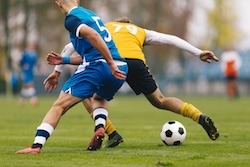
Discover Extracorporeal Shockwave Therapy's (ESWT) game-changing potential for athlete recovery. Let's consider how integrating ESWT into your clinic can revolutionize the treatment of sports injuries to enhance athlete rehabilitation.
What is Extracorporeal Shockwave Therapy
Shockwave therapy is being hailed as one of today's most innovative approaches to treating acute and chronic musculoskeletal pain and connective tissue disorders. Two types of shockwaves are radial pressure wave (EPAT(R)) and focused shockwave (ESWT). Both types are backed by evidence and work well in tandem with a range of complementary regenerative solutions for exceptional outcomes.
Radial pressure wave (EPAT) features high-energy acoustic pressure waves with the most significant energy at the source, so it is best suited for large treatment areas. Focused shockwave (ESWT) deeply penetrates tissue and produces focused power at targeted depths.
Overall, Extracorporeal Shockwave Therapy is a healing accelerator and is particularly efficacious in treating athletes.
How Does Extracorporeal Shockwave Therapy Work for Athletes?
Extracorporeal Shockwave Therapy (ESWT) stimulates a cascade of biological responses across cellular, tissue, and organ levels. Applying shockwave in treatment stimulates regeneration and awakens the body's natural healing system. This approach yields multiple advantages, including heightened collagen synthesis, cellular proliferation, accelerated wound healing, pain reduction, neovascularization, and diminished inflammation.
Recognized as a game-changing therapeutic approach, Shockwave technology is backed by Level 1 evidence and brings about these multifaceted benefits to promote recovery and well-being at various physiological levels.
When it comes to treating athletes, the ability to perform at a high level matters. That’s why there is a particular urgency to address musculoskeletal injury or dysfunction to get them back to their sport of choice as soon as possible. The option to avoid injections and/or surgical intervention is welcomed by athletes seeking relief. Shockwave therapy is an exceptional treatment option that offers athletes a safe means for an expedited return to competition, requiring minimal to no downtime.
Also, noteworthy, many can maintain their training regimens throughout the treatment period. For athletes who suffer common overuse injuries, this non-invasive treatment offers a welcome alternative to traditional protocols.
While treatments are customized for each patient; generally, treatment times are 10 to 15 minutes in length, with weekly visits of approximately 4 – 6 weeks. Many athletes experience some relief and analgesic effects after the first treatment.
Shockwave Therapy for Athletes: From High School Stars to Professionals
Shockwave therapy for athletes is backed by Level 1 evidence and is appropriate for athletes of every level of competition. There are numerous considerations to ensure a safe and efficacious return to play. Below are best practices for treating high school athletes to pros:
Shockwave Therapy for High School Athletes
Comprehensive Evaluation
With young athletes, it’s critical to begin with a thorough assessment, including the impact of the injury, complete medical history, and current physical health. Consulting with a sports medicine specialist may be advisable when considering shockwave therapy for athletes in this age group.
Conservative Treatment
High school athletes are still in the process of developing on many levels. For this reason, there is exceptional value in choosing the most optimal and conservative treatment methods, including shockwave therapy. Physical therapy, rest, and possible bracing or taping may also support the recovery plan.
Non-Invasive Alternative to Surgery Ideal for High School Athletes
It’s important to avoid surgery whenever possible, particularly when treating young athletes. Shockwave therapy is non-invasive, safe, and awakens healing potential within the body. It is an exceptional treatment option for high school student-athletes and their parents and guardians to consider. The non-invasive treatment requires none of the following risks: incisions, pain prescriptions, scarring, or extended recovery periods.
Educating Athletes and Parents
Provide guidance and reassurance to the high school athlete and their parents or guardians about the injury. Suggest a shockwave therapy treatment plan and highlight the accelerated recovery timeline and safety of the protocol. Emphasize the importance of honoring the supportive rehabilitation program and avoiding premature return to play.
Rehabilitation Progression
High school athletes must adhere to a graduated approach to recovery, careful to gradually increase the intensity and duration of training times in alignment with how the athlete responds to treatment. Carefully monitor their progress and modify the rehabilitation program as needed.
Shockwave Therapy for Collegiate Athletes
Embrace a Multidisciplinary Approach
A team approach is commonplace in collegiate athletics. Collaboration often includes coaching staff, trainers, and the medical team to develop a best-in-class treatment and rehabilitation plan. Seamless communication effectively facilitates the coordination of care.
Customized Care
Tailor the treatment plan to the specific needs and demands of the individual athlete, contemplating sport intensity, position played, and level of competitive play. Shockwave therapy complements many regenerative approaches, such as PRP and manual therapies.
Active Rehabilitation
Shockwave advances healing timelines, supporting a faster return to play. Despite that, collegiate athletes must follow a customized rehabilitation plan to prepare them to safely return to the demands of competitive play. Gradual reintegration for the athlete returning to team play is encouraged and will include close supervision of the coaching staff and medical team.
Shockwave Therapy for Professional Athletes
Expert Care Team
Pro athletes are supported by a team of specialists, including elite sports medicine doctors, physical therapists, trainers, coaches, and nutritionists. Coordinating closely with this team is imperative for optimal outcomes.
Game-Changing Technology
Leverage the power and advantages of the latest advancements in sports medicine technology, such as shockwave therapy devices with adjustable energy levels for targeting injured tissues. Consider complementary treatments such as regenerative medicine techniques, including PRP and stem cell therapy, to amplify advanced tissue healing.
Dynamic Rehabilitation
It’s best to offer a comprehensive rehabilitation program focused on restoring optimal function and performance. Strength equipment, drills, and graduated training levels are utilized to facilitate rehabilitation and performance success.
Winning Return to Play Protocol
Develop a strategic return-to-play protocol that gradually increases the athlete's workload and exposure to growing athletic demands as preparation for return-to-play situations—gauge performance improvement using objective readiness measures to support a safe and sustainable return to competition.
Whether you are treating high school, collegiate, or professional athletes, it's critical to prioritize their long-term health and well-being. Consider the importance of injury prevention, proper movement, and meticulous professional conditioning. In each category of athletes, careful follow-up is imperative to address any lingering symptomatology, and prevent injury recurrence.
How to Use Extracorporeal Shockwave Therapy for Athletes
Numerous scientific studies support the efficacy of ESWT in treating multiple musculoskeletal and soft tissue disorders. In the athletic population, overuse issues arise repeatedly, and a concerted effort is made to treat them and make a return to sport possible quickly. Extracorporeal Shockwave Therapy gets to the root cause of the dysfunction and accelerates healing.
Let's dive into predominant athletic injuries and how shockwave can help treat each condition.
Achilles Tendinopathy
Repetitive minuscule injuries and tears to the tendon fibers take an enormous toll on the Achilles tendon and the athlete enduring the injury. Athletes who suffer from Achilles tendinopathy may experience pain, swelling, stiffness, and limited mobility.
Using Extracorporeal Shockwave Therapy for Achilles tendinopathy is exceptionally effective. Explore the evidence to see how you can help athletes in your care score functional gains - quickly and efficiently; read this study.
Tennis or Golfer's Elbow
Lateral epicondylitis (Tennis elbow) and medial epicondylitis (Golfer's elbow) are common inflammatory conditions triggered by repetitive motion. Both are prevalent among athletes, and they can benefit from shockwave therapy.
Stress Fractures
Bone stress injuries (BSI) frequently plague runners, and due to the associated prolonged time necessary away from sport, the toll it takes is physically and mentally impactful. And while the diagnosis can be disheartening, shockwave offers new hope. A recent retrospective study by Alexander Beling, MD, Amol Saxena, DPM, Karsten Hollander, MD, and Adam S.Tenforde, MD, explores the effectiveness of ESWT in the management of BSI in runners.
Frozen Shoulder
This frustrating ailment among athletes impinges shoulder movement, limiting motion and affecting daily living. The severity of the frozen shoulder will dictate your approach to shockwave therapy. EPAT will effectively address the broader area, and ESWT will treat it in a more focused manner. Review a Practice profile that includes a case study on frozen shoulder.
Plantar Fasciitis
This inflammatory condition is commonplace in athletic populations and causes severe heel and arch pain, with particularly acute symptoms upon rising or taking that first step out of bed in the morning. The plantar fascia, which connects the heel bone to the toes, becomes inflamed and is exacerbated by overuse.
This condition is excruciating and can sideline athletes because even standing and walking is difficult, never mind performing at a high level. Fortunately, the efficacy of Extracorporeal Shockwave Therapy for Plantar fasciitis is well-established and proven by multiple clinical trials and meta-analyses, and here's one to explore.
Rotator Cuff Injuries
Rotator cuff injuries can be acute or chronic. Usually, the pain increases at night, and the presence of shoulder weakness is part of the symptom profile. Calcium deposits may also form on the shoulder tendon. Dive into this study for full details of findings on treating with shockwave, "Effects of High-Energy Extracorporeal Shockwave Therapy on Pain, Functional Disability, Quality of Life, and Ultrasonographic Changes in Patients with Calcified Rotator Cuff Tendinopathy."
Strained Calves or Hamstrings
These injuries are high on the list of conditions among athletes of all ages, and published studies prove the efficacy of ESWT for both calf strains and hamstrings.
Shin Splints
Considered a painful condition, shin splints occur from inflammation in the muscles, tendons, and tissues surrounding the tibia. Also referred to as Medial tibial stress syndrome, it was one of 8 functional lower limb injuries explored in a study focused on the effectiveness of shockwave therapy, and it was determined that ESWT delivers multiple effects contributing to tissue healing and pain relief.
Hip Pain
Hip pain in athletes comes in many forms, and Extracorporeal Shockwave Therapy has been shown to greatly alleviate hip pain. Peruse a patient success story about an avid golfer and weightlifter who received shockwave treatment and now plays the best golf of his life.
Jumper's Knees
Another frequently seen overuse injury that can develop slowly over time and become chronic. The results are in - Extracorporeal Shockwave Therapy demonstrated greater effectiveness and safety compared to traditional conservative approaches to chronic patellar tendinopathy.
What are the Benefits of Offering ESWT for Athletes in Your Clinic?
As you can see, Extracorporeal Shockwave Therapy offers far-reaching benefits for your practice and the athletes you treat. Explore the benefits of ESWT:
1. Improved Patient Outcomes
Patient wellness and care are your top priority, and ESWT equips you to deliver optimal patient results. Accelerated healing made possible by Extracorporeal Shockwave Therapy expands your continuum of care to offer innovative, non-invasive solutions. Shockwave is used to transform patient care and treat a wide range of medical issues and is particularly advantageous in treating athletes.
2. Reduced Need for Invasive Surgery
Patients today want non-surgical treatment options for faster healing — with no downtime, no anesthesia, and no risk. Adding shockwave therapy to your care offering elevates patient care by helping athletes get back to the activities they love without the need for invasive procedures. That's a winning scenario.
3. No Downtime
Unsurprisingly, athletes are fiercely competitive and motivated to be in motion. Because shockwave requires little to no downtime, athletes can return to top form quickly.
4. No Risk
Treatment with shockwave is non-invasive, and there are no known associated risks for healthy athletes. There are certain conditions where ESWT is contraindicated (when pregnant, in the presence of a heart condition or pacemakers, taking meds that are known to interfere with blood flow). But otherwise, for an athlete without underlying concerns, there is a clear upside to this convenient, safe, and effective in-office treatment.
5. Little to No Side Effects
ESWT is extraordinarily safe. While athletes may experience mild swelling, bruising, and temporary aches in the days following the initial procedure, serious adverse side effects are not known to occur.
6. Faster Recovery Timelines
Accelerated healing is made possible with regenerative shockwave and is responsible for quickly getting ailing athletes back in motion. An athlete back in play is a happy athlete and a satisfied patient.
7. Increased ROI
Bolster ROI when you incorporate shockwave in your practice offerings. With this innovative medical technology, you can attract a new influx of patients. Nowadays, athletes seek out Extracorporeal Shockwave Therapy by name.
 |
"If you're doing orthopedics, sports medicine, PM&R, and especially if you're doing orthobiologics, you may be missing out on maximizing your treatments if you are not using shockwave." Dr. Brice Blatz, MD |

|
"From what I've seen, there's no other treatment approach that gets the results that shockwave delivers. When it comes to getting athletes better, faster and back in the game, this technology is invaluable." Dr. Jason Levy, DC |
Have questions? Contact us today, and we'll connect you with one of the experts on our team.


